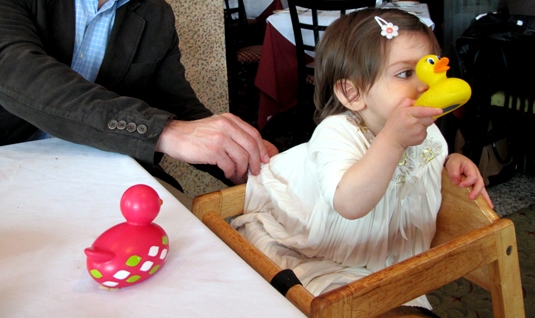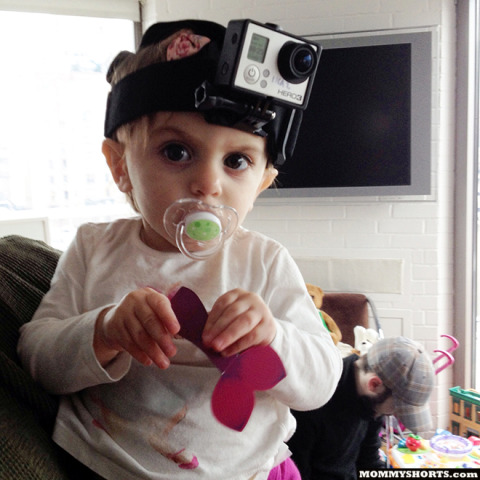Tomorrow is Thanksgiving which means the large majority of us will be trying to sit for an extended period of time with our kids at a table. Unfortunately, getting Miley Cyrus to keep her tongue in her mouth would be easier than making most toddlers stay seated. Mazzy, for instance, has made her disdain for sitting at a table apparent through numerous high-chair-suicide-dive attempts.
For reasons I cannot explain (maybe babies were switched at the hospital?), food is not enough to keep my child entertained. Mazzy finds eating boring and would rather be doing just about anything else.
So. In the interest of a happy Thanksgiving, I had no choice but to devise a rope and duct tape strategy. But just as I was about to leave for the hardware store, I realized I had one other option.
Advice from Dr. B!
If you're new to Mommy Shorts and haven't experienced the expert of advice of Dr. B (aka my sister), you are in for a treat.
——————————————–
Toddlers are known for their short attention spans, high activity levels, and impulsivity. They love testing boundaries, especially the word “no,” throwing objects, and playing with their food. By nature, toddlers are challenging dinner guests so if you want your toddler to stay seated for an extended meal like Thanksgiving, you need to plan ahead and come prepared.
9 STRATEGIES TO KEEP YOUR TODDLER SEATED AT THANKSGIVING DINNER
1. Measure your child’s attention span: Prior to dinner, observe your child playing independently and track how many seconds or minutes he/she plays with one toy before moving on to another one. The key word here is 'independently', meaning without your support or guidance. If your child plays with an object for 2 minutes, expect your child to need a switch in activities every 2 minutes at the table. If your child plays with a toy for 5 minutes, consider yourself lucky.
2. Observe the types of toys that hold your child’s attention best: Toddlers usually like toys that engage their senses and satisfy their curiosity with cause and effect relationships (e.g., toys that he/she can bang together, throw, shake, squeeze, connect, open and close, push and pull, or stack and knock down). Make note of all toys that are travel sized and fall into this category.
3. Create a special travel bag of fun and interesting items: Pack a small bag with your child’s favorite travel size toys and other novel items that have a cause and effect element. Keep these items special by limiting access to times when you are away from home. You can purchase new toys, use household objects, or items that are already in your handbag. Ideas include a small change purse, a key chain, a compact mirror, paper and crayons, yarn, a pill box, a small flash light, clothes pins, small paper cups to stack, stickers or post-its, etc. Although you will be able use some items more than once, it is best to bring at least 10 small items.
TIP: Party stores (like Party City) are great places to buy interesting, colorful, interactive, and inexpensive small toys that wind up, turn, light up, or spin at the press of a button.
4. Plan a course of action: The most difficult times for your child will probably be (1) the time between sitting down at the table and waiting for the food to be served and (2) after your child is finished eating (and the rest of the table is still eating). Make sure to save special items that your child typically can sit with for an extended period for these more challenging times.
5. Limit access and use the element of surprise: Start the evening by giving your child one toy at a time, selecting the toy for your child (without showing him/her the options), and try to switch items just before your child loses interest (unless they resist the switch). Usually parents wait until their child gets bored of playing with something before introducing something new but its better to try to switch activities before your child loses interest to build his/her attention span and prevent the item from losing its novelty. After introducing all the items once, pair a few items together or let your child choose. Encourage creativity and model new ways to play with the items if necessary.
6. Serve food strategically: Food can be a great way to keep your child occupied IF he/she is hungry. Don’t take any chances. Distribute food slowly in very small portions to draw out the eating part of the meal. Bring your child’s favorite drinks and food as back-up if you’re not sure he/she will like the food served.
7. Give your child frequent positive attention and opportunities to socialize: Make sure to positively attend to your child without placing too many demands on him/her (which he/she may want to avoid by getting up from the table). Ask questions he/she knows the answer to, describe what he/she is playing with, praise him/her for sitting and playing nicely at the table, and give him/her opportunities to entertain your guests. For older toddlers, teach rules for sitting at the table and praise and reward him/her for following the rules. Most toddlers need direct verbal or physical attention (i.e., talking, helping, touching, bouncing) at least one time per minute for every year of their age to maximize sitting time.
8. Take planned breaks from sitting: Toddlers like to move so get up a few times during the meal to help your child feel less antsy. Plan a walk to the bathroom before eating and a brief walk or an opportunity to sit on your lap (and bounce) after the meal. Your toddler will be more likely to sit back down at the table without protest if you provide opportunities for movement and exploration on your terms before your child begins to make requests to get up.
9. Use media devices as a last resort: When all else fails, use media devices such as smart phones or electronic games. Although these devices should be used in moderation with toddlers (if at all), this would be the time to use them since your need for your child to be quietly occupied is greater than his/her actual capacity to sit still.
And last but not least, try to enjoy your dinner!
— Dr. B


























Excellent tips, Dr. B! I like that I can use these on any eating occasions.
My strategies also include:
1. The dessert Threat: any leaps from the chair that result in brain trauma mean I get to eat their dessert.
2. The Stink Eye: a silent threat from across the table if grandparents/aunts insist on sitting next to them, letting the wee ones know that if they aren’t good then punishments will be doled out later in the form of a Dora-and-Spongebobless evening.
Also, aforementioned duct tape and rope with a side of Velco Pants.
Happy Thanksgiving!
I am a fan of portable DVD players and colour wonder activities (so can colour without the worry of marking up things that should remain as stainfree as possible 😉 I also make sure the food is prepped for my toddlers plate before she sits, as gives the hot food time to cool down before she starts to shovel it in her mouth … And I try to have an area set up where she can get down when finished eating … relaxing over dinner is a decidely adult luxury and child torture application 😉 Obviously not possible in all locations such as home of glass or restaurant ( in which case one of us does get down with her), but most places we have been able to let her down to play after a reasonable time spent eating/socializing.
This is such great advice. Sounds so practical and easy to implement. However, handing small interesting objects to my toddler is an invitation for her to see how far they can fly. Enter a table strewn with wine glasses and we have a problem
Clarification: DVD on low volume, AFTER has spent reasonable time eating or being amused in other ways, but has now hit the proverbial wall, as is, quite frankly, bored out of her skull, and we want to spend at least five minutes having time to eat our own food ( of which the hot items are now stone cold and the cold items an icky lukewarm temp), sip our first glass of wine alongside those on their second or third, and have a conversation where my participation is more than ” No thank you. I said No thank you! Listening ears please. You colour. No, YOU colour. OK, Mommy colour. You’re hungry, thirsty? But Mommy hasn’t eaten yet … Ok, it’s OK, no crying. I’ll get you more, there you go. No, stay seated. Stay in your seat … OK, Mommy’s lap. NO, don’t touch that! Danger! It’s OK, you are a good girl, but you can’t have that knife/red wine/hot coffee). That’s Mommy’s bread … OK, you can eat it. Oh no thank you … no thank you … I don’t need you to feed me. You eat it . It’s OK, stop crying … Mommy just doesn’t want your soggy already chewed bread … hey, you ate your dinner, you want to watch DORA?”
My trick is to sit my daughter [nearly 2] nearby her older cousins [4 and 6]. She adores them and will laugh at ANYTHING they say or do… buys me at least 5-10 minutes to scarf down some food myself… 🙂
These are AWESOME! I need more small toys to carry around in my purse. Why do I think I can just leave home with water, food, and diapers??? I’m so silly…
My new trick is letting Ella, before leaving the house, pack a small bag with a few small toys. Then I sneak in a few additional ones when she’s not looking, to increase the surprise factor. She can entertain herself for quite a while rearranging her little doll, robot, flower, bracelet, dinosaur,etc. on the table and then on her chair once she squirms onto the floor. Plus putting them into and taking out of the little bag. Wrapping up in napkin, etc. It’s having a variety of stuff that makes it work.
All great ideas. Will be using all of them for our 6 hr plane trip in two weeks. Luckily we are spending tomorrow at home. Still not sure if I can convince TSA duct tape and rope are perfectly acceptable items in a diaper bag…
Bribery has just started to be effective with Mazzy- a very happy thing. The Stink Eye however is not yet understood.
Where does one purchase velcro pants? I’d like to add them to my holiday gift guide.
At home I would never sit Mazzy down before the food was ready but a restaurants this is definitely a difficult period. And the “too hot” thing can be a real problem. If Mazzy tastes something and it is too hot, her interpretation is that she doesn’t like it and won’t try it again.
I’m gonna see if i can figure out an area she can play at the house we are going tonight, but Mazzy is very resourceful and will find her way out soon enough.
We actually tried this last night at our traditional pre-Thanksgiving dinner (aka the children of divorce holiday special) and it really worked.
I went to Party City like my sister suggested and got her all new little cheap toys to play with. Because she had never seen them before, she didn’t throw them because she was curious to see what they were.
The whole evening was a lot of work but we did succeed at keeping her at the table. And the planned trips to the bathroom worked brilliantly. I never dreamed she would willingly get back into her high chair afterward.
I’m just nervous that we showed all our cards last night and the toys will have lost their novelty for this evening- our actual Thanksgiving dinner. But my sister says they should still work.
We’ll see!
Mazzy loves older kids. There will be one at our dinner tonight but jury is out as to whether he will want to play with her. Fingers crossed!
I know. I’m the same. I travel as light as possible. But we tried this strategy last night and it totally worked (see comment above). And all the toys filled a small make up bag that I put in my purse.
Whdn we go out to eat I request the kids meals be prepared immediatelyand left to rest while the adult meals are cooked. This always works to have warm, not too hot food, for the kids and mine is always scalding hot like I like it . 🙂
I have heard others offer their kids wrapped toys. Take said toys from party city and wrap them up in pretty wrapping paper. Especially for airplane trips, it adds to the excitement of the toy and takes an additional 30 sec to unwrap. I haven’t tried this one, as I wasn’t sure it was setting a bad precedent to get a “present” for just behaving. Still more socially acceptable than duct tape!
Hey,
I love the ideas you have shared with us.
I have small toddler and i will execute same ideas on this Halloween.
Thank you so much